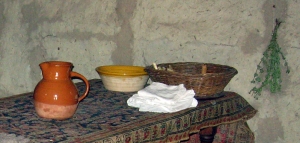 When I was writing Flight of the Sparrow, I spent many happy hours researching 17th century food customs.
When I was writing Flight of the Sparrow, I spent many happy hours researching 17th century food customs.
One of the earliest written recipes from New England is for “stewed pompion.” (“Pompion was a term used for both pumpkins and squash.) It was known as a “standing dish” because it was eaten with nearly every meal. (The recipe included a warning that this dish “provokes urine extremely and is very windy.”)
Slice ripe pompions, and cut them into dice, and so fill a pot with them of two or three gallons, and stew them upon a gentle fire a whole day, and as they sink, they fill again with fresh pompions, not putting any liquor to them; and when it is stewed enough, it will look like baked apples. Dish, putting butter to it, and a little vinegar (with some spice, as ginger, &c.) which makes it tart like an apple, and so serve it up to be eaten with Fish or Flesh.
A modern version, developed by experts at Plimoth Plantation, is easier to follow in the 21st century:
4 cups of boiled squash, roughly mashed
3 tablespoons of butter
2 to 3 teaspoons of cider vinegar
1 to 2 teaspoons of ground ginger
1/2 teaspoon of salt
Heat all ingredients together over medium heat. Adjust seasonings to taste and serve hot.
Another food that intrigued me was a “posset.” A posset was a frothy hot drink made from curdled milk, eggs, ale or wine, and spices. It was often used as a remedy for mild illness, such as a cold. Possets were served in posset pots, which usually had two handles and a spout. A well-made posset had three layers: the top was foam, or “grace;” the middle was a smooth spiced custard; and the bottom was the alcoholic liquid. The grace and custard were eaten with a spoon and the “sack” or alcohol at the bottom was sucked through the spout.
Here’s a posset recipe from 1671, followed by two modern versions:
Take a pottle of cream, and boil in it a little whole cinnamon, and three or four flakes of mace. To this proportion of cream put in 18 yolks of eggs, and 8 of the whites; a pint of sack; beat your eggs very well and then mingle them with your sack. Put in 3/4 of a pound of sugar into the wine and eggs, with a nutmeg grated, and a little beaten cinnamon. Set the basin on the fire with the wine and eggs and let it be hot. Then put in the cream boiling from the fire, pour it on high, but stir it not; cover it with a dish, and when it is settled, strew on the top a little fine sugar mingled with three grains of ambergris, and one grain of musk, and serve it up.
Posset
![Posset pot, Netherlands, Late 17th or early 18th century, Tin-glazed earthenware painted in blue V&A Museum no. 3841-1901[1] Victoria and Albert Museum, London](https://amybeldingbrown.wordpress.com/wp-content/uploads/2013/11/posset_pot-3.jpg?w=300&h=233)
Posset pot, Netherlands, Late 17th or early 18th century, Tin-glazed earthenware painted in blue V&A Museum no. 3841-1901[1] Victoria and Albert Museum, London
1 quart of whipping cream
1 pint of ale
10 medium egg yolks
4 medium egg whites
1 cup sugar (or less according to your preference)
1 tsp. grated nutmeg
In a large stew pan combine the cream and ale and whip them together gently with a whisk.
In a mixing bowl vigorously whip your egg whites until very frothy. Add the egg yolks to the whites and continue to whip until very well blended and add to the cream and ale.
Add the sugar and nutmeg. Over a medium heat cook the mixture, stirring all the while, until it thickens. This should not be runny and not a thick custard either.
It can be served from a small punch bowl to individual bowls or in glasses.
Sack Posset
1/2 cup sugar
2 qts. milk
4 egg yolks, beaten
4 cups medium sweet sherry
Grated nutmeg or powdered cloves
Add sugar to milk in a saucepan. Mix well and heat to just barely scalding. Beat in the egg yolks. Stir in the sherry. Serve warm in punch cups, dusted lightly with nutmeg or cloves.

